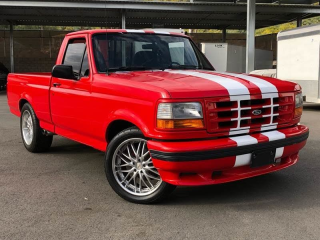The Good
The 1993 F-150 offers a blend of practicality and nostalgia. Performance is adequate for work and daily driving. Reliability is decent, especially with proper maintenance. While not luxurious, the comfort is acceptable. Its classic, boxy design appeals to many. Its affordability and reputation for durability make it a valuable choice, appealing to both budget-conscious and sentimental buyers.
The Bad
Potential weaknesses of the 1993 Ford F-150 include rust, particularly in areas prone to road salt. The automatic transmissions can be prone to issues with high mileage. Fuel economy is not great, especially with the larger engines. Some electrical components may also start to fail due to age, and finding replacement parts could become challenging.
1993 Ford F-150: Quick Overview
- Engine Options:
- 4.9L Inline-6 (300 CID): Producing around 145-150 horsepower.
- 5.0L V8 (302 CID): Producing around 185-205 horsepower.
- 5.8L V8 (351 CID): Producing around 200-210 horsepower.
- Horsepower: Varies from 145 to 210 hp depending on the engine.
- Fuel Economy:
- 4.9L I6: Approximately 15-18 mpg city / 20-23 mpg highway.
- 5.0L V8: Approximately 14-17 mpg city / 18-21 mpg highway.
- 5.8L V8: Approximately 12-15 mpg city / 16-19 mpg highway.
- 0-60 Times: Not a primary focus for this truck, but estimated to be in the range of 9-12 seconds depending on the engine and configuration.
- Towing Capacity: Ranging from approximately 5,000 to 7,500 pounds, depending on engine, drivetrain, and axle ratio.
- Trim-Level Features:
- XL: Base model, typically equipped with vinyl seats, basic instrumentation, and a standard AM/FM radio. Often work-oriented.
- XLT: Mid-range trim, offering cloth seats, carpeting, upgraded interior trim, and possibly air conditioning and upgraded audio systems.
- Eddie Bauer: Luxury-oriented trim, featuring two-tone paint, unique interior styling, premium cloth or leather seats, power windows and locks, and various convenience features.
1993 Ford F-150 Specifications
Vehicle Information
| Year | 1993 |
| Make | Ford |
| Model | F-150 |
| Trim | - |
| Style | - |
| Type | Truck |
| Category | Standard Pickup Truck |
Manufacturing Details
| Made In | United States |
| Manufacturing City | OAKVILLE |
Dimensions
| Doors | 2-Door |
| Curb Weight | 4239 pounds |
| Gross Vehicle Weight Rating | 6250 pounds |
| Overall Height | - |
| Overall Length | - |
| Overall Width | - |
| Wheelbase Length | - |
| Standard Seating | - |
Engine & Performance
| Engine | M11 |
| Engine Size | 4.9L |
| Engine Cylinders | 6 |
| Transmission | Automatic 4-Speed |
| Transmission Type | Automatic |
| Transmission Speeds | 4-Speed |
| Drivetrain | Four-Wheel Drive |
Additional Features
| Anti-Brake System | - |
| Steering Type | - |
Pricing
| Manufacturer Suggested Retail Price (MSRP) | - |
| Invoice Price | - |
| Delivery Charges | - |
Vehicle History Report
Specifications
History
Events
History Check
Check
Check
Check
Check
Listings
Recalls
Check
Analysis
What Problems Does the 1993 Ford F-150 Have?
Engine issues can include oil leaks, particularly around the rear main seal and valve covers. The 5.0L and 5.8L V8 engines can experience carbon buildup and issues with the electronic fuel injection (EFI) system. The Inline-6 (4.9L) is generally considered more reliable, but can still suffer from wear and tear over time.
Electrical problems, such as faulty sensors, wiring corrosion, and issues with the instrument cluster, are also common. The aging wiring harness can become brittle, leading to shorts and other electrical malfunctions.
While recall information specific to the 1993 model year should be verified through official sources (NHTSA), common recalls for this generation often involved issues with the fuel system and safety equipment. Long-term reliability hinges heavily on maintenance. Neglecting regular oil changes, transmission fluid flushes, and cooling system maintenance can significantly shorten the lifespan of critical components.
How long will the 1993 Ford F-150 last?
What Technology & Safety Features are Included?
Entertainment: Standard models typically included an AM/FM radio. Higher trims (XLT, Eddie Bauer) might have featured cassette players or even an optional CD player. Power windows and locks were available on higher trims.
Driver-Assistance: Driver-assistance features were minimal, limited to power steering and power brakes. Anti-lock brakes (ABS) were an available option.
Safety Features: Standard safety equipment included seatbelts. Airbags were not standard in 1993 F-150 models.
Optional Features: Optional features included air conditioning, cruise control, tilt steering wheel, and upgraded sound systems.
Crash-Test Ratings: Crash test data for vehicles of this era is limited and may not be directly comparable to modern standards. NHTSA (National Highway Traffic Safety Administration) conducted some crash testing, but the results should be viewed in the context of the safety standards of the time. The Insurance Institute for Highway Safety (IIHS) may also have limited data available. Given the lack of modern safety features like airbags and advanced driver-assistance systems, the 1993 F-150 provides significantly less crash protection than newer vehicles. Buyers should prioritize safety when considering a vehicle of this age. It's important to consult official sources for accurate and up-to-date crash test information if available.
What Colors Options are Available?
Exterior Colors
Interior Colors
1993 Ford F-150 Prices and Market Value
1993 Ford F-150 Cost of Ownership
1993 Ford F-150 Fuel Efficiency
1993 Ford F-150 Safety Rating
NHTSA
IIHS
1993 Ford F-150 Insurance
reasonable repair costs.
How Does the 1993 Ford F-150 Compare to Other Truck?
In terms of features, the F-150's trim levels offered a range of options, from basic work trucks to more comfortable and well-equipped models. Chevy and Dodge offered similar trim level choices. The Toyota Pickup tended to be more utilitarian.
Reliability is a key consideration for vehicles of this age. The Ford F-150 is generally considered reliable, but like its competitors, it can suffer from age-related issues. The Toyota Pickup is often cited as having superior reliability.
In terms of price, the used market prices for these trucks are now largely driven by condition and mileage. Similar alternatives include the Chevrolet C/K 1500 and Dodge Ram 1500 of the same era. These offer a similar experience in terms of performance, features, and reliability. The Toyota Pickup might be a better option for someone prioritizing reliability and fuel economy over towing capacity.



